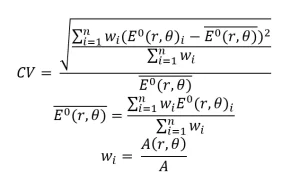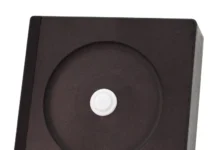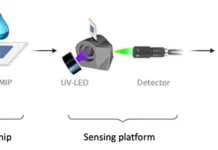Ataollah Kheyrandish
Department of Chemical and Biological Engineering, University of British Columbia, Vancouver, Canada
Madjid Mohseni
Department of Chemical and Biological Engineering, University of British Columbia, Vancouver, Canada
Fariborz Taghipour
Department of Chemical and Biological Engineering, University of British Columbia, Vancouver, Canada
A robust, validated protocol for studying the kinetics of microorganism inactivation is key to advancing the development of UV LED systems for water treatment. Two critical aspects of such protocol include the operation of UV LEDs and the determination of UV fluence. The authors have investigated the effects of operational conditions and measurement techniques on the radiant power output of various UV LEDs using a specially designed and fabricated set-up [1]. It was demonstrated that operating conditions, including the electrical current and solder temperature of the UV LED, significantly affect the power and peak wavelength output. Measurement techniques and equipment – such as detector size, detector distance from the UV LED and potential reflection from the environment – were shown to influence the UV LED results. The results obtained from these studies were analyzed and applied to findings to develop a protocol for UV LED characterization [1].
A method also was developed to determine the average fluence inside a water sample in a UV LED experimental set-up [2]. In this method, average fluence was estimated by measuring irradiance at several points of collimated and uniform radiation on a petri dish surface. New correction parameters have been defined and proposed, and several existing parameters for determining the fluence of the UV mercury lamp apparatus [3] have been modified to measure and quantify the collimation and uniformity of the radiation. The application of new correction factors for fluence determination has been proposed and evaluated by performing a kinetic inactivation study of representative waterborne microorganisms [2].
In this article, a summary is presented of the aforementioned studies on measuring UV LED radiant flux and intensity distribution. Also presented is a step-by-step protocol for determining UV fluence. This work could serve as a basis for the development of general guidelines for UV LED inactivation studies. Once a standardized UV LED test protocol is developed and validated, it can be applied to obtain correct and comparable inactivation kinetic data.
Spectral radiant flux and radiant intensity distribution measurements
Considering the nature of the UV LED radiation, the operation and output characteristics of UV LED radiation must be considered in any protocol for UV LED inactivation studies on microorganisms. Electrical current and operational temperature are among the most important parameters affecting the radiant power and radiation distribution profile of UV LEDs. Besides, the set-up configuration, detector characteristics and measurement technique affect the reported/measured output of UV LEDs [1]. The radiant output measurement guideline includes the design and fabrication of a testing set-up; a means for selecting operation devices, such as detector and temperature maintaining devices; and a technique for proper measurement. The extent to which each parameter affects the output of UV LEDs has been discussed elsewhere [1]. Practical aspects of the most typical cases are focused on by presenting the protocol as a flowchart (Figure 1).
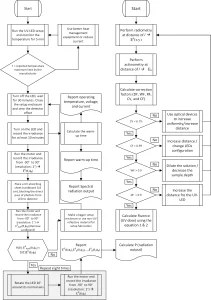
Apparatus
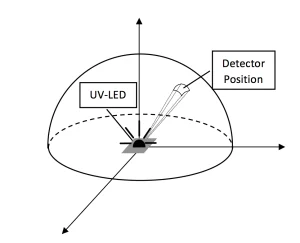
The radiation profile of a UV LED is a crucial parameter that affects the measurement of UV output and the design of UV LED reactors. The goniometric method can be used to measure the radiation distribution of a hemisphere enclosing the UV LED. As the radiation profile of UV LEDs is not axially symmetrical, the goniometer must be used in both the azimuthal and polar directions of the hemisphere. A schematic view of the proposed set-up has been presented in Figure 2.
Temperature and current control
Temperature and current are dependent parameters that affect the radiation output of UV LEDs. Based on the thermal management of a UV LED system and the operational electrical current, LED temperatures could reach steady state values after a few minutes, which may not be within the safe operating temperature range reported by the manufacturer. Therefore, a thermometer must be used to monitor temperature during the operation of the LED. A thermoelectric cooler and heat sink may be combined for temperature control. A constant current power supply is needed to operate the UV LED. If the LED needs to be dimmed, the current limit of the power supply needs to be lowered to ensure that the LED operates in constant current mode – in this case, the current is the limiting parameter.
Detector characteristics
It is suggested that a spectrometer is used to measure irradiance and spectral power distribution. To ensure a correct irradiance measurement, a cosine corrector must be used. In addition, all measurements must be performed at distances greater than the critical distance, which is dependent on the size of the LED and detector surface. There are several considerations, which are as follows:
- The detector must face the LED during measurement so that the normal axis of the detector surface intersects the surface of the LED.
- The acquisition rate of the detector must be at least 1 s.
- Detector calibration should be performed once a year through a third party.
- Utilizing a detector with a relatively small surface size is preferable (for example, 0.12 cm2).
Measurements and calculations
UV LEDs are relatively small UV sources with die surfaces as small as 1 mm, which makes them more similar to a point source than mercury lamps. However, at very close distances, these UV sources cannot be considered point source radiation illuminators. To determine the minimum distance at which UV LEDs can be considered point sources compared to the detector surface, irradiance must be measured and compared at different distances from the UV LED. With an ɛ% error acceptance margin, the minimum distance (Dmin) for measuring the irradiance of a UV LED-detector combination can be calculated using the following equation:
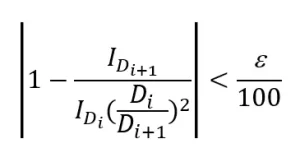
where IDi is the irradiance at distance Di, Dmin is the maximum distance that verifies the above condition, and Di+1 = Di + 5 mm. All measurements must be made at distances greater than or equal to Dmin.
Turning on a thermoelectric cooler before operating the LED applies less temperature stress on the UV LED than turning them on simultaneously. Thus, a thermoelectric cooler or any means of passive heat dissipation must be turned on before turning on the UV LED. The operational current of most available UV LEDs is measured in milliamps. As the radiant power of UV LEDs is highly dependent on electrical current, a constant current power supply to an accuracy of three decimal places is recommended for monitoring the electrical current online.
Following the proposed flowchart (Figure 1), the radiation output of a UV LED can be calculated using the following equation, where r is the distance from the UV LED to the detector (cm); E is the measured irradiance (mW.cm−2); θ and φ are the polar and azimuthal angles, respectively; and P is the radiant power of the UV LED (mW):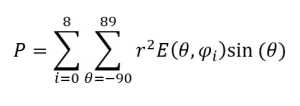
Report contents
It is recommended that the following information be included in the report:
- Operational conditions, such as temperature, electrical current and voltage
- UV LED manufacturer datasheet and soldering procedure
- Power supply manufacturer and model number
- Detector manufacturer, model and calibration time
- Position of the thermocouple on the UV LED mounting board
- Minimum distance from the UV LED needed to measure its irradiance
- Warm-up time and irradiance vs. time data from the moment the UV LED is turned on
- Spectral power distribution of the UV LED
- Calculated radiant power of the UV LED
- Three-dimensional radiation profile of the UV LED
- Distance at which the radiation profile of the UV LED has been measured
- Acceptable error range for the minimum distance and any impact of reflection on the measurements
Fluence determination
An accurate protocol has been widely used to determine fluence in UV mercury lamp systems; however, such a protocol cannot be applied to UV LED systems without considering their different radiation output. In this proposed protocol, parameters used in the UV lamp protocol were revised, new parameters defined, and a new apparatus to determine fluence for UV LED systems proposed. Unlike in the UV lamp protocol, both actinometry and detector measurement (radiometry) are needed to determine the proper set-up configuration of UV LED systems. As demonstrated in studies [2], when the proper set-up has been designed and fabricated, either actinometry or radiometry would be sufficient. The goal of this protocol is to determine fluence rate in a petri dish containing microorganisms and other constituents.
Apparatus
A modular design for the experimental set-up is recommended to accommodate both radiometry and actinometry experiments. There is no need for a similar set-up for different experiments, as there is when setting up the bench scale collimated beam apparatus of mercury lamps. As long as the apparatus minimizes reflection and can accommodate both actinometry and radiometry at a distance of 15 cm from the UV LED, the results of different users are comparable. The 15 cm distance guarantees that the point source assumption for the UV LED and detector combination is valid and that an acceptable collimation and uniformity of radiation are achieved.
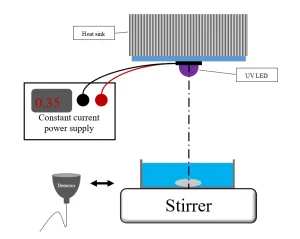
This term is valid for a typical UV LED with a viewing angle of about 120° and the standard radiation distribution profile. For actinometry, the petri dish surface center must be aligned with the UV LED die, and the radiometry axis must be in line with the LED principal radiation access (Figure 3). A petri dish of 5 cm in diameter and 1.5 cm in depth is recommended. The petri dish must be filled with the sample/solution to the edge to avoid any internal petri dish wall reflection effect. An example of the set-up with all details has been given elsewhere [1].
Radiometry
The radiation distribution on an x–y surface, in parallel with the surface of the LED at a distance of 15 cm, must be measured with a detector. The axis origin of this surface ([x, y] = [0,0]) must be aligned with the LED’s die position. Irradiance must be measured from [x, y] = [−2.5, −2.5] cm to [x, y] = [2.5, 2.5] cm every 2 mm. The detector orientation for all measurements must ensure that the normal vector of the detector is parallel with the normal vector of the radiometry surface. The results of radiometry are given as irradiance as a function of x and y (that is, E0(x, y)).
Actinometry
Regarding the peak wavelength of the UV LED, measured for characterizing the output of a UV LED, proper actinometry must be used with a relatively high absorption at the peak wavelength of the LED [4]. Due to the polychromatic radiation emission of UV LEDs, iodide-iodate actinometry is suggested for UV LEDs in the UV-C range. That is, the quantum yield and molar absorption coefficient for fluence calculation must be weighted based on the radiation spectrum of UV LEDs. The actinometry solution must have the same position and volume as that of the water sample. The irradiance obtained by actinometry is given as fluence rate at the surface of the petri dish (E0).
Correction factors
Both actinometry and radiometry provide irradiance or fluence rates at the surface of the petri dish. However, the average fluence/fluence rate over the volume of the sample also may be of interest. Four correction factors are needed to translate the measured surface irradiance/fluence rate to the average fluence rate in the water sample: divergence factor (DF), water factor (WF), reflection factor (RF) and the coefficient of variation (CV).
Divergence factor
Performing radiometry at a suggested distance of 15 cm from the LED guarantees the point source assumption for the UV LED. The DF can be calculated using the following equation, where d is the distance from the UV LED (cm), and l is the depth of the petri dish (cm):
Reflection factor
For a water sample, the RF is a function of radiation wavelength. Using Fresnel law and the refractive index of water at different wavelengths [5], RF can be calculated as a function of wavelength (RFλ). However, at relatively long distances from the UV LED (15 cm), the monochromatic assumption is valid, and RF may be considered the same value as that in low-pressure mercury lamp systems (RF = 0.975).
Water factor
Here, WF represents a quantification of the radiation gradient over the depth of the water sample. Like RF, WF is a function of wavelength and must be calculated over the radiation spectrum of the UV LED. For a petri dish with a depth of l (cm), WF at λ wavelength can be calculated using the following equation, where aλ is the molar absorptivity of the water sample (M−1 cm−1):
Coefficient of variation
The CV represents the uniformity of radiation at the surface of the petri dish. In order to measure the fluence of a water sample, radiation gradient at the surface of the petri dish must be quantified. The circular geometry of the petri dish must be used to obtain an understanding of the radiation gradient at its surface. It is recommended that polar coordinates be used to calculate CV. The irradiance distribution at the petri dish surface, in polar coordinates, can be calculated from the irradiance measurement (in Cartesian coordinates and measured using radiometry) using the following equation:
For r′ from 0 to the radius of the petri dish and θ′ from 0 to 180, irradiance can be measured at the petri dish surface, after which the CV can be calculated using the following equation, where n is the number of irradiance calculations, wi is the weight of the area at which the irradiance was calculated, A is the area, and  is the average irradiance at a distance of r and a polar angle of θ:
is the average irradiance at a distance of r and a polar angle of θ:
The maximum acceptable CV is 6.7%, which ensures the same uniformity as mercury lamp apparatuses achieve when the petri factor is higher than 0.9. For set-ups with CVs higher than this value, optical devices, such as lenses and UV collectors, may improve radiation uniformity.
Collimation factor
Collimation factor (CF) quantifi es the collimation of radiation delivered to the water sample. For the proposed set-up, the only parameter that affects collimation is the distance from the UV LED. It has been shown that, for a distance of 15 cm, near collimation can be achieved in typical LEDs with a viewing angle of about 120°. However, for cases in which multiple UV LEDs are used, this distance must be evaluated again to assure near complete collimation. The collimation factor can be calculated as the ratio of irradiance to fluence rate at the surface of the petri dish. The fluence rate is measured by actinometry, and the average irradiance at the petri dish is ![]() .
.
Fluence determination
Following the flowchart presented in Figure 1 and meeting the criteria in the set-up design, the average irradiance inside the water sample can be determined using the following equation, where Pλ is the portion of LED radiation output at λ wavelength (mW nm−1), P is the radiant power of the UV LED, and E is the average irradiance in the petri dish sample volume:
Once the collimation and uniformity of radiation have been assured, the fluence rate and fluence for the water sample can be calculated using the following equation, where![]() is the average fluence rate, F0 is the average fluence (UV dose) in the petri dish and t is the exposure time:
is the average fluence rate, F0 is the average fluence (UV dose) in the petri dish and t is the exposure time:
Although the radiation distribution in a petri dish is affected by the radiation profile of the source, the proposed protocol is independent of UV source radiation profiles. Thus, this protocol can be implemented for any UV radiation source. The only consideration is to ensure accurate measurement of the irradiance distribution and fluence rate at the surface of the petri dish.
Consequently, all correction factors can be calculated independently of the UV source radiation profile.
References
- A. Kheyrandish, M. Mohseni, and F. Taghipour, “Development of a method for the characterization and operation of UV LED for water treatment,” Water Res., vol. 122, pp. 570–579, 2017.
- A. Kheyrandish, M. Mohseni, and F. Taghipour, “Protocol for Determining Ultraviolet Light Emitting Diode (UV LED) Fluence for Microbial Inactivation Studies,” Environ. Sci. Technol., vol. 52, no. 13, pp. 7390–7398, Jul. 2018.
- J.R. Bolton and K.G. Linden, “Standardization of Methods for Fluence (UV Dose) Determination in Bench-Scale UV Experiments,” J. Environ. Eng., vol. 129, no. 3, pp. 209–215, Mar. 2003.
- H.J. Kuhn, S.E. Braslavsky, and R. Schmidt, “Chemical actinometry (IUPAC Technical Report),” Pure Appl. Chem., vol. 76, no. 12, pp. 2105–2146, 2005.
- M.N. Polyanskiy, “Refractive index database.” [Online]. Available: https://refractiveindex.info. [Accessed: 20-Jan-2019].
Contact: Madjid Mohseni, madjid.mohseni@ubc.ca; or Fariborz Taghipour, fariborz.taghipour@ubc.ca





